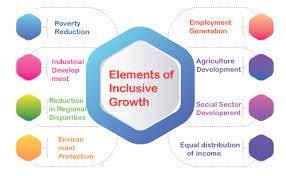
NEED FOR INCLUSIVE FRAMEWORK FOR INCLUSIVE DEVELOPMENT
NEED FOR INCLUSIVE FRAMEWORK FOR INCLUSIVE DEVELOPMENT I RACE IAS : Best UPSC Coaching in Lucknow I Current Affairs
NEED FOR INCLUSIVE FRAMEWORK FOR INCLUSIVE DEVELOPMENT
Mains General Studies: 3
(Issues and Challenges related to Indian Economy)
Context:
- For inclusive development in the country, it is necessary to have an inclusive framework.
- Absence of basic facilities in villages, migration from villages and increase in population pressure in cities, negative impact on economy related to agriculture, is not right from the point of view of inclusive development. Experts are of the opinion that the agriculture sector needs special attention to achieve the goal of rapid inclusive growth in India.
- After independence, there have been mainly two challenges before India: first, nation building and second, socio-economic progress. For their solution, development administration started emphasizing on the multifaceted and planned development of the society. This kind of voiceless, rootless and futureless development has not resulted in the inclusive development of the country.
What is Inclusive Development:
- Inclusive growth is a concept of development that includes employment opportunities and helps reduce poverty. It empowers people through equality of opportunity and education and skills. The goal-oriented concept of inclusive development includes all basic facilities, such as housing, food, drinking water, health and means of livelihood, etc.
- Inclusive development includes all other development including social, economic, political and technological development.
- The concept of inclusive growth was first introduced in the 11th Five Year Plan.
- It is noteworthy that during the year 2012-17, the 12th Five Year Plan was completely focused on inclusive growth and its theme was 'Rapid, Inclusive and Sustainable Growth'.
Government Initiatives/Schemes for Inclusive Development:
For Social Development
For Financial Inclusion:
For the upliftment of Women:
For the Development of Farmers and Agriculture
For the Development of the Disabled
|
Challenges related to Inclusive Development:
- Increase in Migration from Rural areas: In the absence of inclusive development, migration from villages to cities increases. Due to lack of basic facilities in villages, people migrate from villages to cities. Due to this excessive increase in population in the cities, various problems start arising.
- Decline in Agricultural Productivity: Migration to urban areas has a negative impact on the agricultural economy and leads to a decline in agricultural productivity.
- Corruption: Corruption not only increases public distrust towards the government but also has a negative impact on the economy of a country. Therefore, corruption hinders the pace of inclusive development.
- Lack of Employment Generation: In the absence of inclusive development in rural areas, there is always a lack of permanent and long-term employment resources. The schemes already operating in rural areas are not able to provide permanent employment to the people.
Solutions for Inclusive Development:
- Priority to Backward states: Compared to other states, backward states need to be supported more by investing in physical and human capital, technology, building institutions and better governance etc.
- Formalization of the Economy: Jobs should be created in the formal sector to ensure social security. Presently more than 90% of the employment belongs to the unorganized sector.
- Reforms in Governance: To ensure equitable distribution of resources, reforms in governance should be made to make it accountable, efficient and participative as well as its functioning.
- Strengthening Social infrastructure: Efforts should be made towards universal health coverage, increasing insurance coverage, providing skill training and creating an environment that encourages employment generation and entrepreneurship, and increasing public expenditure on health and education.
- Promotion of Micro Small and Medium Enterprises (MSME): Since MSME is a labor intensive sector, it should be encouraged through state support. Existing challenges like power cuts, increase in compliance cost due to GST, lack of marketing skills etc. should be addressed to ensure access to local and international markets.
- Promotion of Agriculture sector: This sector should be provided by the government with the use of technology and facilities of low cost fertilizers and pesticides.
Conclusions:
- The government has allocated sixty thousand crore rupees in the Union Budget 2023-24 for MNREGA, which plays an important role in the inclusive development of the country.
- It is eighteen percent less than seventy three thousand crores in the budget of 2022-23 and about thirty two percent less than the revised estimate.
- The budget cut in MNREGA may become a new problem for the ongoing inclusive development towards rural employment.
- MNREGA is the world's largest social welfare program which has inspired a positive change in rural labour.
- In order to develop an inclusive framework of inclusive growth in the country, the government should pay wages to the agricultural laborers in the state under the rules of the Minimum Wages Act, 1948.
- Inclusive structure should be strengthened with decentralization of Panchayati Raj governance system.
- The government had set a target of doubling the income of farmers by 2022. Experts are of the opinion that the agriculture sector needs special attention to achieve the goal of rapid inclusive growth in India.
----------------------------------------------------------------------
|
Mains Exam. Question: What is the concept of inclusive development? Discuss the challenges related to inclusive development and their solutions.
|
2 Comments

हेल्लो सर आपके द्वारा मनरेगा योजना के बारे मे दी गयी जानकारी सच मे बहुत अच्छा है https://www.bluehunts.com/manrega-yojna/
bluehunts
27-Jun-2023 09:33 PM
हेल्लो सर आपके द्वारा मनरेगा योजना के बारे मे दी गयी जानकारी सच मे बहुत अच्छा है https://www.bluehunts.com/manrega-yojna/
bluehunts
27-Jun-2023 09:33 PM